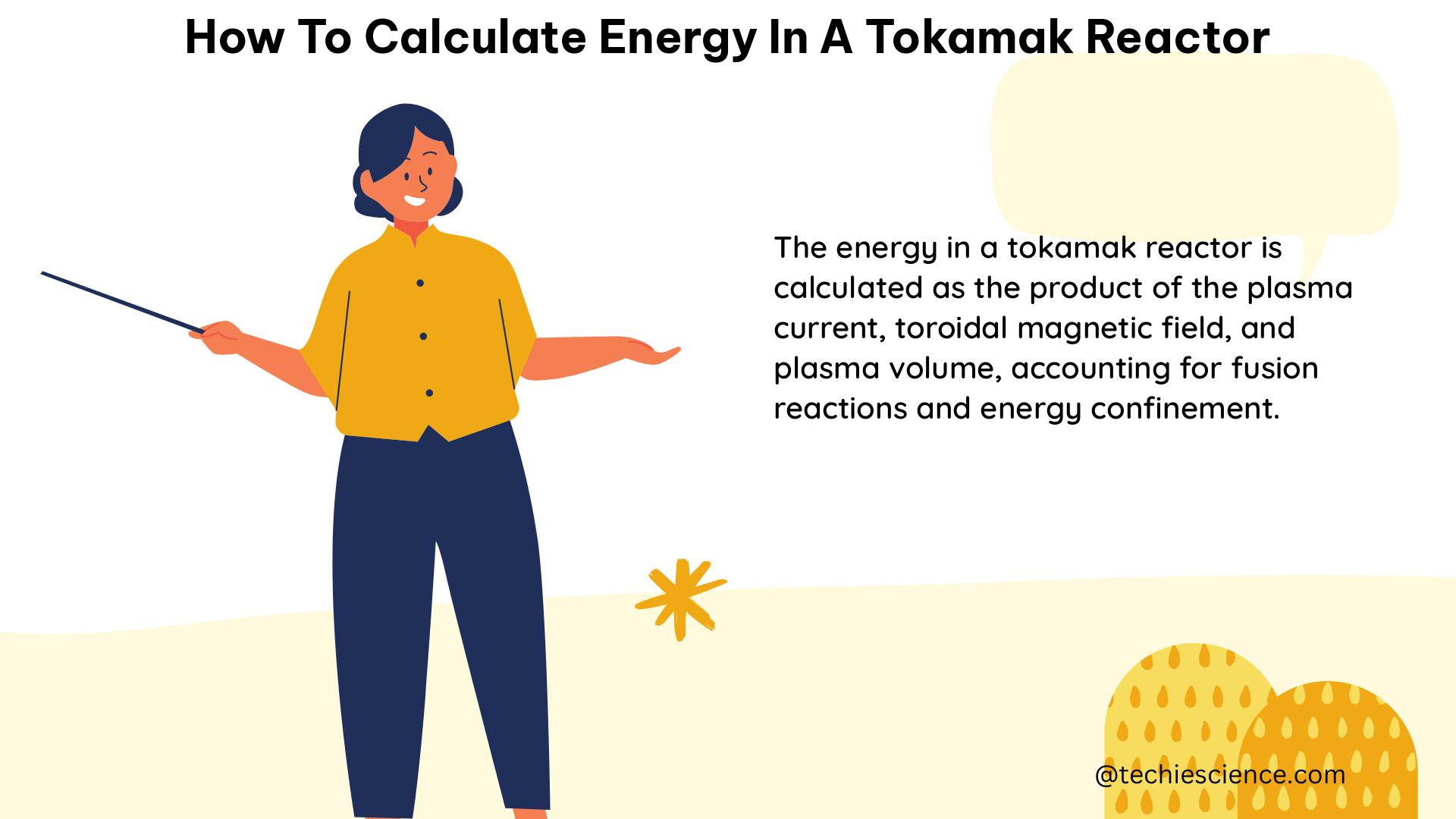Summary
Calculating the energy in a tokamak reactor involves understanding the key parameters, such as energy confinement time, fusion power gain, plasma temperature, plasma density, and magnetic field, as well as the relevant equations, including the power balance equation, energy gain equation, and fusion power density equation. This comprehensive guide provides a detailed explanation of these concepts, along with example calculations and references to help you master the art of energy calculation in a tokamak reactor.
Key Parameters in Tokamak Reactor Energy Calculation

Energy Confinement Time (τE)
The energy confinement time, τE, is a crucial parameter that measures how well the magnetic field insulates the plasma in a tokamak reactor. A higher τE indicates a more effective fusion reactor, as it means the plasma can be better contained and heated to the required temperatures for fusion reactions to occur.
The energy confinement time is typically expressed in seconds and can be calculated using the following formula:
τE = W / P_loss
where W is the total stored energy in the plasma, and P_loss is the power lost from the plasma due to various mechanisms, such as radiation, particle transport, and heat conduction.
Fusion Power Gain (Q)
The fusion power gain, Q, is the ratio of the fusion power produced to the power injected into the plasma to drive the reaction. A higher Q value indicates better performance, as it means more energy is being generated from the fusion process compared to the input power.
The fusion power gain is calculated using the following equation:
Q = P_fusion / P_injected
where P_fusion is the power produced by the fusion reactions, and P_injected is the power injected into the plasma to sustain the reaction.
Plasma Temperature (T)
The plasma temperature in a tokamak reactor is typically in the range of 100-200 million degrees Celsius, which is required to achieve the high temperatures necessary for fusion reactions to occur. This parameter is crucial in determining the reaction rate and the overall energy output of the reactor.
Plasma Density (n)
The plasma density in a tokamak reactor is typically around one million times less dense than air. This low density is necessary to allow the plasma to be effectively confined and heated by the magnetic fields.
The plasma density is typically expressed in particles per cubic meter (m^-3) and is an important factor in the calculation of the fusion power density.
Magnetic Field (B)
The magnetic field in a tokamak reactor is used to confine and heat the plasma. The strength of the magnetic field is a critical parameter that affects the overall performance and energy output of the reactor.
Equations for Calculating Energy in a Tokamak Reactor
Power Balance Equation
The power balance equation in a tokamak reactor is given by:
P = P_fusion - P_heat_loss
where P is the net power output, P_fusion is the power produced by the fusion reactions, and P_heat_loss is the power lost due to heat transport across the magnetic field.
Energy Gain Equation
The energy gain equation, as mentioned earlier, is:
Q = P_fusion / P_injected
where P_injected is the power injected into the plasma to drive the reaction.
Fusion Power Density Equation
The fusion power density equation is given by:
P_fusion = (1/16) * n^2 * <σv> * E
where n is the plasma density, <σv> is the fusion reaction rate, and E is the energy released per fusion reaction.
Example Calculations
Calculating Fusion Power Density
Let’s consider a tokamak reactor with the following parameters:
– Plasma density, n = 10^20 m^-3
– Fusion reaction rate, <σv> = 10^-22 m^3 s^-1
– Energy released per fusion reaction, E = 17.6 MeV
Using the fusion power density equation, we can calculate the fusion power density as:
P_fusion = (1/16) * (10^40 m^-6) * (10^-22 m^3 s^-1) * (17.6 * 10^6 eV)
= 1.75 MW/m^3
This means that the fusion power density in this tokamak reactor is 1.75 MW/m^3.
Calculating Energy Gain
Suppose we have a tokamak reactor with the following parameters:
– Fusion power output, P_fusion = 500 MW
– Injected power, P_injected = 50 MW
Using the energy gain equation, we can calculate the energy gain as:
Q = P_fusion / P_injected
= 500 MW / 50 MW
= 10
This means that the energy gain in this tokamak reactor is 10, indicating that the fusion power output is 10 times the injected power.
Additional Considerations
- The energy confinement time, τE, is affected by various factors, such as the plasma size, magnetic field strength, and plasma heating methods. Improving the energy confinement time is a key challenge in tokamak reactor design.
- The fusion reaction rate,
<σv>, is dependent on the plasma temperature and the specific fusion reaction being considered (e.g., deuterium-tritium, deuterium-deuterium). - The energy released per fusion reaction,
E, varies depending on the fusion reaction, with the deuterium-tritium reaction releasing the most energy (17.6 MeV). - Optimizing the balance between the fusion power output and the power lost due to heat transport is crucial for achieving high-efficiency tokamak reactors.
References
- The Path to Fusion Power by NCBI: https://www.ncbi.nlm.nih.gov/pmc/articles/PMC6172097/
- Fusion Energy by IAEA: https://www.iaea.org/topics/fusion-energy
- Designing a Tokamak Fusion Reactor by MIT: https://dspace.mit.edu/handle/1721.1/122837

The lambdageeks.com Core SME Team is a group of experienced subject matter experts from diverse scientific and technical fields including Physics, Chemistry, Technology,Electronics & Electrical Engineering, Automotive, Mechanical Engineering. Our team collaborates to create high-quality, well-researched articles on a wide range of science and technology topics for the lambdageeks.com website.
All Our Senior SME are having more than 7 Years of experience in the respective fields . They are either Working Industry Professionals or assocaited With different Universities. Refer Our Authors Page to get to know About our Core SMEs.